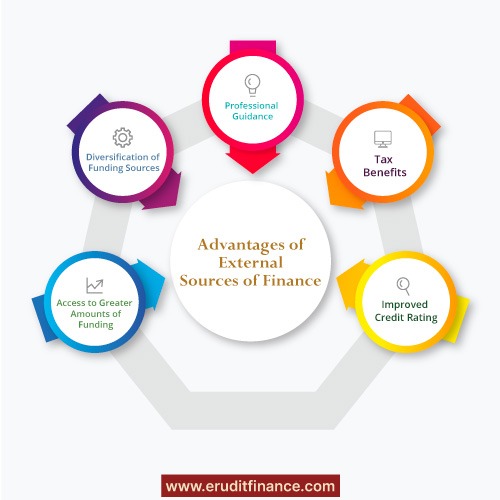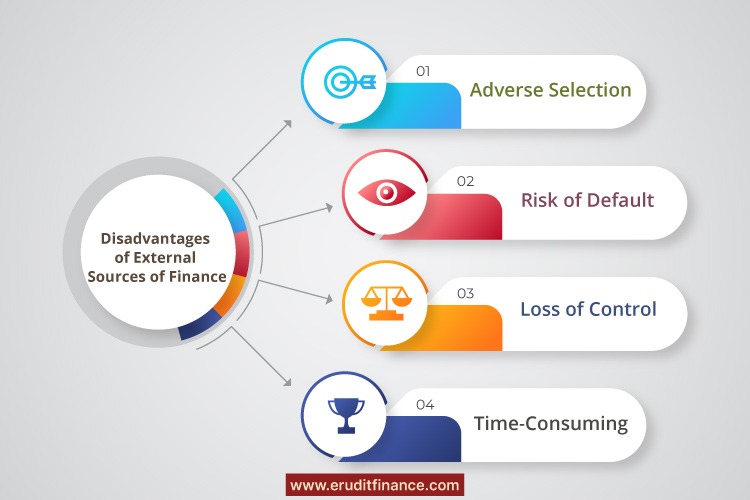Introduction to What are the Source of External Finance
External finance can be an important tool for businesses looking to expand or grow their operations, but it’s important for business owners to carefully evaluate their options and choose the source of finance that best suits their needs and circumstances.
In this article, we will discuss in detail about What are the Source of External Finance.
Let’s Dive In
What is External Financing?
External financing refers to the process of raising funds or capital from outside sources such as banks, investors, or other financial institutions. It is a way for a company, organization, or individual to obtain the necessary resources to fund their business operations or projects.
External financing can take various forms, including equity financing, where a company raises funds by selling shares to investors, or debt financing, where a company borrows money from banks or other lenders and agrees to repay the borrowed funds plus interest over time. Other forms of external financing include grants, subsidies, and loans from governments or other institutions.
External financing can be an important source of funding for businesses that need to invest in growth opportunities, expand their operations, or make strategic acquisitions.
However, it often comes with various costs and risks, such as interest payments, potential loss of ownership or control, and potential default or bankruptcy if the borrowed funds cannot be repaid.
What are Examples of External Sources of Finance?
Here are some examples of external sources of finance.

The appropriate source of finance will depend on the amount of funding needed, the length of time the funds are required, and the cost and terms of the financing.
Why are External Sources of Finance Important?
External sources of finance can be important for a variety of reasons
- Access to more capital- External financing can provide access to more capital than what may be available through internal sources, such as retained earnings or personal savings. This can enable a business to pursue growth opportunities, invest in new products or services, or acquire other businesses.
- Diversification of funding sources- Relying solely on internal funding sources can limit a company’s financial flexibility and increase the risk of financial instability in the event of an economic downturn or unexpected expenses. External financing can help to diversify a company’s funding sources and reduce its dependence on any one source of funding.
- Professional guidance- Many external financing sources, such as banks, venture capitalists, or angel investors, can offer valuable expertise and guidance to businesses. They may have experience in the industry or market that the business operates in and can provide advice on strategic decision-making, financial management, and other business operations.
- Tax benefits- Certain forms of external financings, such as loans, may offer tax benefits that can reduce a company’s tax burden.
- Improved credit rating- Consistently utilizing external financing sources and making timely payments can help a company build a positive credit history and improve its credit rating. This can help the company secure better terms and rates for future financing needs.
Overall, external financing can provide businesses with the necessary resources and support to achieve their growth objectives, maintain financial stability, and remain competitive in their market.
Advantages and Disadvantages of External Sources of Finance
External sources of finance can offer several advantages and disadvantages, depending on the specific source of funding and the needs of the organization.
Some of the key advantages and disadvantages are given below
| Advantages | Disadvantages |
| Access to greater amounts of funding | Costs |
| Diversification of funding sources | Risk of default |
| Professional guidance | Loss of control |
| Tax benefits | Time-consuming |
| Improved credit rating | Adverse selection |
Advantages

- Access to greater amounts of funding-External financing can provide access to more capital than what may be available through internal sources of finance, such as retained earnings or personal savings. This can help businesses to pursue growth opportunities, invest in new products or services, or acquire other businesses.
- Diversification of funding sources- Relying solely on internal funding sources can limit a company’s financial flexibility and increase the risk of financial instability in the event of an economic downturn or unexpected expenses. External financing can help to diversify a company’s funding sources and reduce its dependence on any one source of funding.
- Professional guidance- Many external financing sources, such as banks, venture capitalists, or angel investors, can offer valuable expertise and guidance to businesses. They may have experience in the industry or market that the business operates in and can provide advice on strategic decision-making, financial management, and other business operations.
- Tax benefits- Certain forms of external financings, such as loans, may offer tax benefits that can reduce a company’s tax burden.
- Improved credit rating- Consistently utilizing external financing sources and making timely payments can help a company build a positive credit history and improve its credit rating. This can help the company secure better terms and rates for future financing needs.
Disadvantages

Costs- External financing often comes with various costs, such as interest payments, fees, or equity dilution. These costs can impact a company’s profitability and reduce its financial flexibility.
Risk of default- Borrowing money from external sources also comes with the risk of default. If a company is unable to repay its debts, it may face legal action, bankruptcy, or damage to its credit rating.
Loss of control- Some forms of external financing, such as equity financing, can result in a loss of control for the business owner. Investors may demand a say in business operations or decision-making, which can limit the owner’s autonomy.
Time-consuming- The process of securing external financing can be time-consuming and may require significant effort and resources, such as preparing financial statements, meeting with lenders or investors, and negotiating terms.
Adverse selection- Lenders or investors may only be willing to finance businesses that they perceive as low-risk or high-potential. This can lead to adverse selection, where businesses with high-risk or lower potential are unable to secure external financing.
Overall, businesses should carefully consider the advantages and disadvantages of external financing before deciding to pursue it. The type of financing that is most appropriate will depend on the specific needs and circumstances of the organization.
What is the Difference Between Internal and External Sources of Finance?
Internal sources of finance refer to the funds or capital that a business generates from within its own operations or assets. Examples of internal sources of finance include retained earnings, working capital, sale of fixed assets, and depreciation of assets. These sources of finance are available to the company without the involvement of outside parties.
On the other hand, external sources of finance refer to the funds or capital that a business raises from external parties, such as banks, investors, or financial institutions. Examples of external sources of finance include loans, equity financing, bond issuance, and government grants. These sources of finance involve the involvement of outside parties and may come with various costs and obligations.
The main difference between internal and external sources of finance is that internal sources are generated from within the company, while external sources require the involvement of outside parties. Internal sources of finance typically have lower costs and may be more easily accessible to the company. External sources of finance can offer larger amounts of funding and may provide access to professional guidance and expertise.
Bottom Line
Choosing between internal and external sources of finance depends on the specific needs and circumstances of the company. Generally, internal sources of finance may be preferred for short-term and low-risk funding needs, while external sources of finance may be more appropriate for long-term and high-risk funding needs.
Hope we have cleared all your doubts on what are the source of external finance.
Still, having doubts?
Put it down in the comment section.










